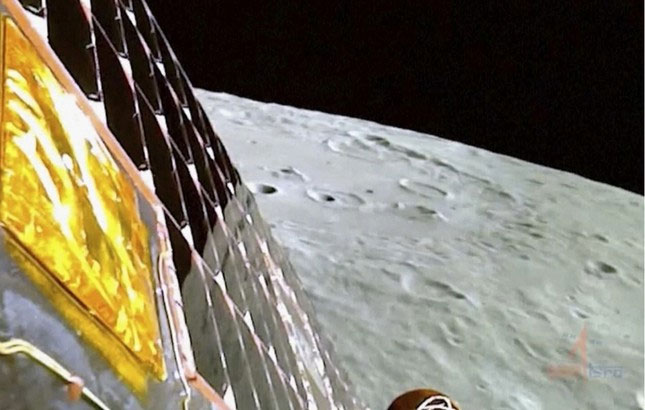Top Chinese space scientist says Indian spacecraft did not land on Moon's south pole
The 'father' of China's lunar exploration program has just refuted India's assertion that the Chandrayaan-3 spacecraft landed on the south pole of the Moon, in what was considered a historic mission last August.
After the Chandrayaan-3 mission landed on the Moon , Indian Prime Minister Narendra Modi said: 'Thanks to the hard work and talent of our scientists, India has reached the south pole of the Moon, where no other country has ever set foot'.

Image of the Moon's surface taken by the camera of the Chandrayaan-3 spacecraft. (Photo: ISRO).
However, a top Chinese scientist has confirmed that the Chandrayaan-3 spacecraft did not land on the Moon's south pole.
The announcement comes as Indian scientists are working to revive the Vikram lander and Pragyaan rover from their 'sleep' state, after a two-week long icy night on the Moon.
Chinese scientist Ouyang Ziyuan made the statement on September 28. Mr. Ouyang is the scientist leading China's first lunar exploration mission .
Mr Ouyang said that the Chandrayaan-3 spacecraft did not land at or near the south pole.
On Earth, the south pole is defined as the area between 66.5 and 90 degrees south, because the Earth's axis of rotation is tilted about 23.5 degrees with respect to the Sun.
Mr. Ouyang argues that because the Moon's tilt is only 1.5 degrees, the south pole is much smaller. NASA considers the Moon's south pole to be the 80-90 degree region, while Mr. Ouyang believes that the Moon's south pole is between 88.5 and 90 degrees, corresponding to the Moon's 1.5 degree tilt.
So far no one has doubted or refuted India's claim that the Chandrayaan-3 spacecraft landed on the south pole of the Moon.
NASA and the European Space Agency have praised ISRO scientists for being able to soft-land near the far side of the Moon. From the start, India made it clear that the Chandrayaan-3 spacecraft would land at around 70 degrees latitude, near the south pole.
A scientist from the University of Hong Kong's Space Research Laboratory dismissed Mr Ouyang's claim.
Quentin Parker, director of the University of Hong Kong's Space Research Laboratory, told the South China Morning Post : 'The moment of landing a spacecraft so close to the south pole and definitely within the region that is defined as the south polar region is a huge achievement. I don't think anything should be taken away from India for that ,' he said.
- India launches a space ship, preparing to explore the Moon
- How does the compass tell us where the North pole is at the South Pole?
- The pole from the North of the Earth is ... shifting
- What terrible disaster will happen if the Earth has 67 moons?
- India launched unmanned ships onto Mars in 2013
- Russia is about to take land on Mars's satellite
- India's spacecraft 'catastrophic' on the Moon, but where the wreck is unknown
- The Indian landing station is about to land on the Moon
- Chinese space station caught fire in the South Atlantic sky
- Dive into the South Pole Sea 97m, the world record
- The object caught fire, fearing the Chinese space station to fall
- Test the BLAST balloon balloon in the South Pole sky
 Van Allen's belt and evidence that the Apollo 11 mission to the Moon was myth
Van Allen's belt and evidence that the Apollo 11 mission to the Moon was myth The levels of civilization in the universe (Kardashev scale)
The levels of civilization in the universe (Kardashev scale) Today Mars, the sun and the Earth are aligned
Today Mars, the sun and the Earth are aligned The Amazon owner announced a secret plan to build a space base for thousands of people
The Amazon owner announced a secret plan to build a space base for thousands of people